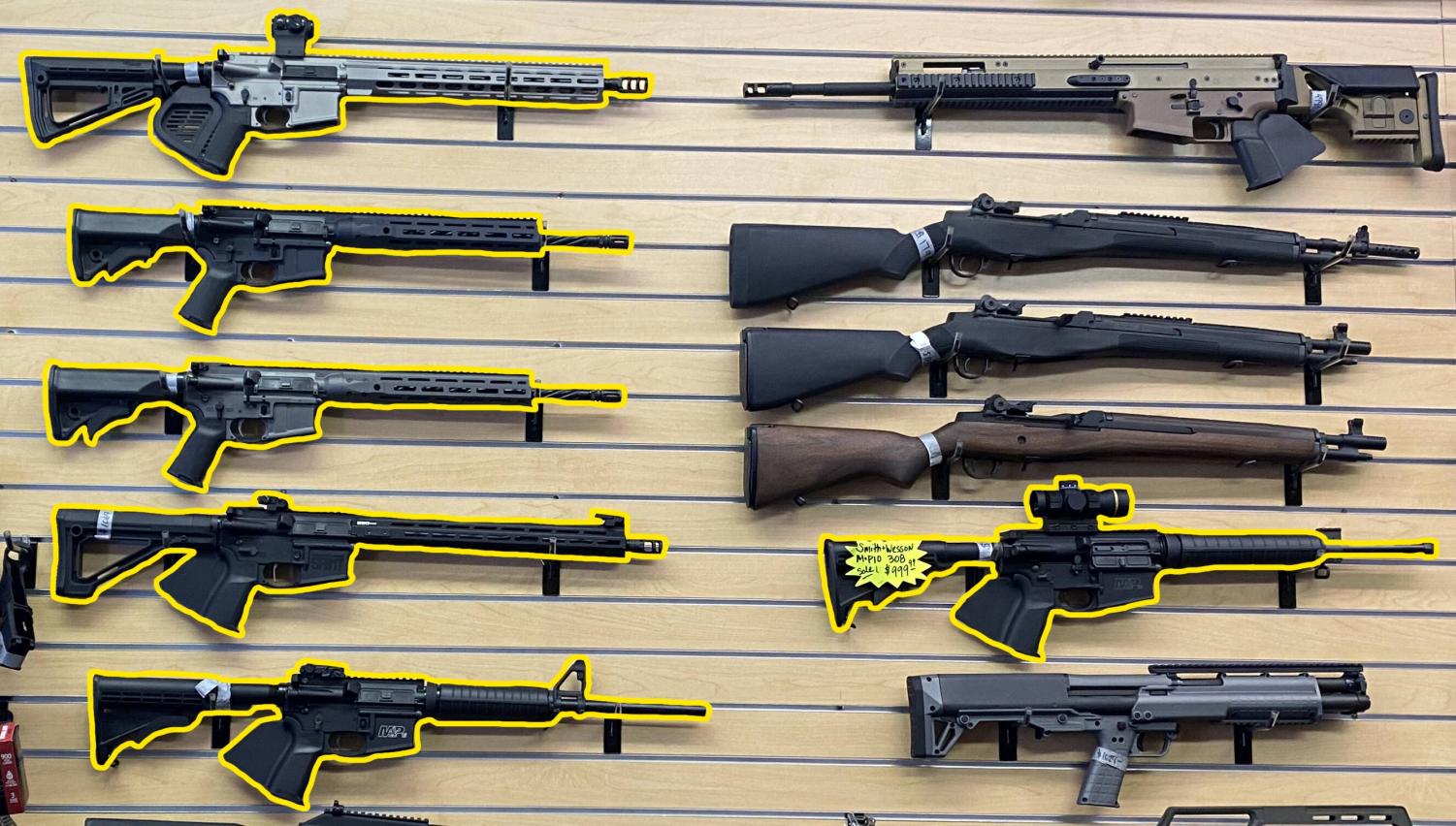[vc_row][vc_column][vc_column_text]Parkland, Las Vegas, San Bernardino, Sandy Hook.
Among others, these are the locations of some of the deadliest mass shootings in America in recent years. During these shootings, hundreds of innocent lives were lost, taken by people that society agrees should not have had guns.
Besides death, there is one thing in common between all of these tragedies: America’s scapegoat, better known as the AR-15.
Always at the forefront of the gun control debate, the AR-15 rifle’s military history has contributed greatly to its reputation of being a mass murder machine in the eyes of the public. However, to truly understand how this perception came to be, one needs to go back and see where the story of the weapon began in 1955, the beginning of the Vietnam War.
According to Ammoland, as the war in Vietnam escalated, the M1 Garand — used by the United States in World War II — was beginning to show signs of age. In turn, the U.S. military began to look for a new weapon that could compete with the AK-47 used by the Vietnamese guerilla fighters. Soon thereafter, weapons manufacturer ArmaLite began development of the AR-10 and later the AR-15 when the AR-10 was rejected by the U.S. Army.
In 1960, Colt’s Manufacturing Company, who had purchased the rights to the AR-10 and AR-15 rifles, made their first military sale to Malaysia. Years later, Colt finally began to see success with the U.S. Military. Colt first impressed the Air Force, then the Army, and by 1963, the military had ordered over 300,000 units to be standardized across all troops.
To this day, the AR-15 — now designated as the M16 — is the primary service weapon for the U.S. military and is also the face of the consumer market for assault-style arms.[/vc_column_text][/vc_column][/vc_row][vc_row][vc_column][vc_raw_html]JTNDaWZyYW1lJTIwc3JjJTNEJTIyaHR0cHMlM0ElMkYlMkZjZG4ua25pZ2h0bGFiLmNvbSUyRmxpYnMlMkZ0aW1lbGluZTMlMkZsYXRlc3QlMkZlbWJlZCUyRmluZGV4Lmh0bWwlM0Zzb3VyY2UlM0QxdWVaU1ROZm1OQ3NPMkZEWFdUQkFTV2xrbF95UUlzNnpuSzg0dlktZHN0cyUyNmFtcCUzQmZvbnQlM0REZWZhdWx0JTI2YW1wJTNCbGFuZyUzRGVuJTI2YW1wJTNCaW5pdGlhbF96b29tJTNEMiUyNmFtcCUzQmhlaWdodCUzRDU1MCUyMiUyMHdpZHRoJTNEJTIyMTAwJTI1JTIyJTIwaGVpZ2h0JTNEJTIyNjAwJTIyJTIwZnJhbWVib3JkZXIlM0QlMjIwJTIyJTIwYWxsb3dmdWxsc2NyZWVuJTNEJTIyYWxsb3dmdWxsc2NyZWVuJTIyJTNFJTNDJTJGaWZyYW1lJTNF[/vc_raw_html][/vc_column][/vc_row][vc_row][vc_column][vc_column_text]At first glance, the AR-15 and its military aesthetic may put forth the idea that it is the same weapon used in war for combat. However, this is not true.
Between military and consumer rifles, there are many differences that can be hard to catch but are incredibly important to recognize.
For instance, military rifles have a selective fire mechanism that allows the weapon to shoot in three different modes: semi-automatic, three-round burst, and fully automatic. These fire modes allow military rifles to have much more firepower than consumer rifles.
Another difference between the two is ammunition capacity. According to fas.org, the M16 rifle has a 20 or 30-round magazine, depending on the variant used. It is illegal to purchase a magazine with a capacity over 10 rounds in California as of 2019; however, anyone who has previously purchased magazines over the limit of 10 rounds can and will be able to keep them.
The most common misconception of the AR-15 is that the “AR” stands for “assault rifle.” Throughout previous years, many people, including politicians, have labeled the AR-15 as a “fully-automatic assault rifle” which, by definition, means that it is a “rapid-fire, magazine-fed automatic rifle designed for infantry use.”
There are a few problems with this statement.
Fully automatic and semi-automatic weapons are drastically different, and each classification has great differences in a weapon’s firepower. As long as the trigger is held down, fully automatic weapons will continue to shoot bullets at a high rate of fire, as opposed to the single-shot nature of a semi-automatic weapon. In turn, fully automatic weapons have significantly more destructive power than semi-automatic weapons like the AR-15.[/vc_column_text][/vc_column][/vc_row][vc_row][vc_column][vc_raw_html]JTNDZGl2JTIwc3R5bGUlM0QlMjJ3aWR0aCUzQSUyMDEwMCUyNSUzQiUyMiUzRSUzQ2RpdiUyMHN0eWxlJTNEJTIycG9zaXRpb24lM0ElMjByZWxhdGl2ZSUzQiUyMHBhZGRpbmctYm90dG9tJTNBJTIwNDguNzUlMjUlM0IlMjBwYWRkaW5nLXRvcCUzQSUyMDAlM0IlMjBoZWlnaHQlM0ElMjAwJTNCJTIyJTNFJTNDaWZyYW1lJTIwZnJhbWVib3JkZXIlM0QlMjIwJTIyJTIwd2lkdGglM0QlMjIxMDY2LjY2NjY2NjY2NjY2NjdweCUyMiUyMGhlaWdodCUzRCUyMjUyMHB4JTIyJTIwc3R5bGUlM0QlMjJwb3NpdGlvbiUzQSUyMGFic29sdXRlJTNCJTIwdG9wJTNBJTIwMCUzQiUyMGxlZnQlM0ElMjAwJTNCJTIwd2lkdGglM0ElMjAxMDAlMjUlM0IlMjBoZWlnaHQlM0ElMjAxMDAlMjUlM0IlMjIlMjBzcmMlM0QlMjJodHRwcyUzQSUyRiUyRnZpZXcuZ2VuaWFsLmx5JTJGNWRlNjA1NjM3MzkyMmUwZmE4ZjYyZGZlJTIyJTIwdHlwZSUzRCUyMnRleHQlMkZodG1sJTIyJTIwYWxsb3dzY3JpcHRhY2Nlc3MlM0QlMjJhbHdheXMlMjIlMjBhbGxvd2Z1bGxzY3JlZW4lM0QlMjJ0cnVlJTIyJTIwc2Nyb2xsaW5nJTNEJTIyeWVzJTIyJTIwYWxsb3duZXR3b3JraW5nJTNEJTIyYWxsJTIyJTNFJTNDJTJGaWZyYW1lJTNFJTIwJTNDJTJGZGl2JTNFJTIwJTNDJTJGZGl2JTNF[/vc_raw_html][/vc_column][/vc_row][vc_row][vc_column][vc_column_text]Though these misconceptions contribute to the negative image of the AR-15, this image is also furthered by the weapon’s appearances in high-profile mass shootings that have shocked the nation.
Many political battles are fought over assault-style weapons such as the AR-15 as well as in the broader arena of gun control as a whole. In California, many progressive developments have been made in the name of gun control due to the advocacy of key Democrats and the youth of California, among other people.
“I think a lot of the rules and regulations we have in California can be thought of as a model for the rest of the country,” John Moore* said. “For example, California has a 10-day waiting period to purchase any firearm. I think that is a good idea because statistically, waiting periods have been shown to reduce impulsive crime like domestic violence or especially suicide.”
According to the Centers for Disease Control (CDC), California has a relatively low gun death rate of around 7.9 deaths per 100,000 people, compared to the national average of approximately 13.6 deaths per 100,000 people.
However, in the recent past, mass shootings have become much more frequent. From June 2015 to the present day, there has been an average of one mass shooting every 48 days, whereas from August 1966 to April 1999, there was an average of one mass shooting every 180 days.
It has been the consensus that many of these mass shootings may stem from an unreliable background check system, as many mass shooters in recent years have had mental health issues or past criminal records. Some believe that the solution to this issue is as simple as digitizing the background check system currently in place, but lobbying has kept these developments from becoming actualized.
“We absolutely have the technology for that to be in place, but the ATF and the FBI kind of have their hands tied in that they aren’t allowed to keep strong digital records on sales, on ownership, [and] on criminal histories. There are a lot of people that can pass the instant criminal background check but really shouldn’t because they have a past conviction or mental health problem that maybe they chose not to disclose on the background check form,” Moore said.
Nonetheless, others believe that the current background check system is already strong enough, and is not the cause of these mass shootings.
“The background check is an FBI [initiative]. If someone has ever been checked into a mental institution under 5150, they’d be denied. California is pretty stringent on people getting denied or approved through the background check. I’ve had people denied over having a bar fight 20 years ago,” Danielle Miller* said.
While the debate on background checks has become more heated, both sides can agree that there are some legislations currently in place in California that are not necessary. For example, now, the background check and 10-day waiting period apply to both law enforcement and the general public.
“The waiting period applies to police officers, FBI agents, and Secret Service, so on that end, it’s a little bit weird. They’re walking in with a gun on them, and they have to wait 10 days for their gun,” Miller said.
Additionally, California has placed bans on certain parts of weapons that would not fit in with needs in other parts of the country.
“In California, we’re mostly living in an urban environment, but for areas of the country that are not so urban, like Alaska, or Montana, or the Midwest, I don’t know that placing those restrictions makes a lot of sense because people in those areas may have different reasons why they want to own guns in the first place,” Moore said. “The majority of people in California own guns for sporting use and personal defense, but somebody in Texas may be purchasing guns so that they can do pest control on their property with wild hogs.”
Frequently at the forefront of the gun control debate are “assault-style” weapons and there are differing views on how these weapons should be handled.
“I think we’re focusing on the assault rifles a little too much. We should focus more on the handguns because that’s what most people use to kill people, and they’re easily hidden,” said Jarrett Smith, a sophomore.
Miller shares Smith’s sentiment. She believes that the reason why assault rifles receive such scrutiny from the media is not that they are more powerful than handguns or hunting rifles.
“I think that the aesthetics of the AR-15 is what people are most scared of because there are many other guns that shoot the same bullet that are legal and don’t have a bunch of regulation against them. They look at it as something more of a military weapon, although [there are other guns here] used by the military as well, and they even take a higher caliber bullet,” Miller said.
Others believe that there should be strong regulation on these assault-style weapons. Still, due to the difficulty of creating a universal definition for an “assault-style weapon,” it is challenging to develop progressive legislation.
“It’s really difficult to make any call on what are exactly the guns you are trying to regulate, particularly the regulation of assault weapons. It’s also really difficult to come up with a definition that works for that; rules are changing constantly and the industry will adapt to exploit the loopholes,” Moore said.
Both sides of the debate agree that it is difficult to reach a consensus to create a working set of laws that satisfy all Americans.
“You want to make sure that if you’re crafting gun control legislation or rules, that it’s going to have the intended effect and that you are going to reduce crime, you are going to reduce [the number of] people who hurt themselves with their guns, but also you don’t want to make it harder for people to just legally enjoy the hobby that they have,” Moore said.
So, the debate continues in hopes of producing a solution that satisfies all and saves as many lives as possible.
*Due to the sensitive nature of the content in this article, this name has been changed to protect the anonymity of the source.[/vc_column_text][/vc_column][/vc_row]






Neminda • Feb 16, 2021 at 8:07 am
One tiny thing guys, 5he AR in the AR-15 actually stands for (Arma-lite rifle). Apart from that tiny thing this article is pretty informative. Also all these gun related problems, especially with the assault rifles arise due to improper regulation of the weapons also because like most people mention because of a few uninformed, uneducated and simply opinionated politicians. If, just like in a building there were a few officers assigned to every state to monitor and report the flow if weaponry in and out of the state along with proper background checks of the owners if the weapons, then these mass shootings would be minimised and also it would create more job opportunities for people. This might not be accepted by everyone, but a bit stricter punishments for felons charged with gun violence would at least deter some of these criminals from performing such atrocities. The reputation of the AR-15 already suffered a major blow when it performed extremely poorly in it’s initial stages at vietnam and so any further crises would only mar its reputation more giving everyone a bad impression of the longest standing assault rifle in the US military. Another problem is with the government itself, they are still pretty much bureaucratic just like, they were when they sent the wrong powdered rounds and refused to have the AR-15’s bore chromed, this too cost thousands of American soldiers their lives in Vietnam. Until a strong change occurs, in both the government’s perception of weapons and maintaining peace, and of the people, the law abiding citizens in possession of guns will have to stand on the fine line of having their weapons totally confiscated and rendered illegal, or continuing to own them under heavy regulations.
victor axelsen • Apr 22, 2020 at 11:34 pm
decide or break your hunt.
I recommend this awesome post choosing the best ar 15 scope for your successful hunt: Top 10 Best AR-15 Optics & i want to find best scope for a 17 hmr
Kap • Feb 12, 2020 at 7:02 am
One thing most people don’t realize is a true assault rifle uses a pistol cartridge, like the Swedish K, H&K MP5
the original M16 was a POS, Veterans died when it malfunctioned
Rich • Feb 11, 2020 at 5:15 pm
FROM THIS SITE:
“We invite comments and responses to our content. Comments that are deemed appropriate and relevant will be published.
If you want a picture to show with your comment, go get a gravatar.”
Rich • Feb 11, 2020 at 5:13 pm
Publius Huldah Powerful Speech:
All Federal and State Gun Control Is Unlawful
http://www.youtube.com/watch?v=Sn6UJbDm2-c
Rich • Feb 11, 2020 at 5:12 pm
a site of moderation must be listed…
New Yorks 1,000,000 new illegal gun owners..
REFUSED TO REGISTER THEIR MEDIA LABELED ASSAULT WEAPONS….
One million plus new felons, all armed with scary, high capacity, media labeled assault weapons! The deadline for New York residents to register their so called “Assault Weapons” and “High” (read standard) Capacity Magazines came and went. An estimated million plus, formerly law abiding, gun owners have refused to comply with Cuomo and down state Democrat’s naive belief that the NY Safe Act, passed in a so called emergency session of the New York legislature, could force free people to register their hard earned property.
And who can blame these once lawful gun owners, with a president that picks and chooses which laws he will follow or enforce, as well as an Federal Attorney General that operates daily with a Contempt of Congress charge and gun running scandal, “Fast & Furious”, hanging over his head. Why should the average New York joe, bother to follow the law, especially when it is in direct conflict with the Constitution of the United States, the one true law of the land.
Will • Feb 11, 2020 at 10:34 am
One other part of the equation I don’t see mentioned here: There are at least TEN MILLION legally-owned “assault weapons” in the US versus the dozen or so that have been used in mass murders (and a few of those were NOT legally owned).